The cursor disappeared. Google AI Bard awaited feedback. A tail wagged like a slow windshield wiper as I looked over his answer. Or was that my imagination? The Copyhacker’s Master of AI course was sending me through an AIDA 35-minute copywriting workout.
Would I find a rival in Google AI’s Bard?
Will you?
I called on my inner John Henry to rise to the challenge of Big Bad Bard. Sledgehammer’s up?
Was Bard ChatGPT’s next contender? Not exactly.
But here’s 9 little known steps (plus a bonus one) to help you turn Bard from competition to compilation on your next email copywriting project.
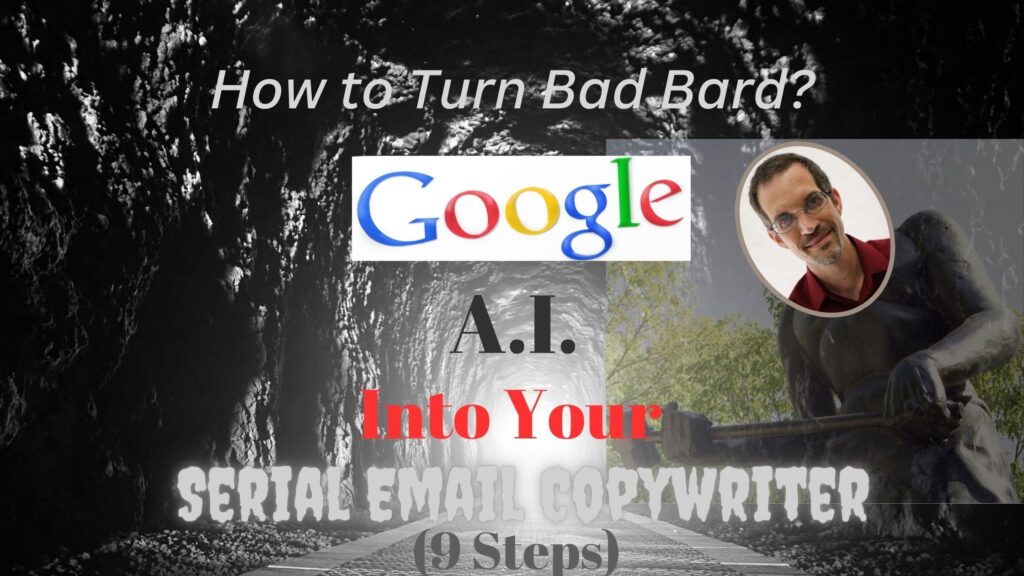
Outline Bard Google AI’s Project Stakes
Assignment? A charity, Buckner’s Shoes for Infant Soles.
Brief? Buckner is a charity that was once an orphanage. And over the years it has taken on more and more projects that help Americans with standard of living challenges.
Plus, they now help the poorest world countries meet their basic needs.
The copywriting project? Write a high-converting email for Buckner’s Shoes for Infant Soles project.
Wireframe? AIDA framework.
What’s AIDA for Bard Users?
Quick review.
Think of AIDA as like an outline for copywriters with much flexibility.
This acronym stands for….
- Attention
- Interest
- Desire
- Action
This copywriter framework favorite moves from an attention-grabbing headline to a sales generating conversation in as little as three lines of text.
1.Break Projects down into Small Bard Google AI Jobs
For my competitor, I discovered from Jo’s course to breakdown Bard’s directives to simple tasks.
Each piece will follow the AIDA sequence. With AI for the best results, think slow. And give the prompts that allow Bard to create each item of the email with specific commands.
These tasks are….
- Email subject title
- Attention grabbing fact or stat.
- Interest tidbit that makes reader curious to read more.
- Desire tells the reader why he should want to act.
- Action that tells the reader what he can do right now after hearing the information.
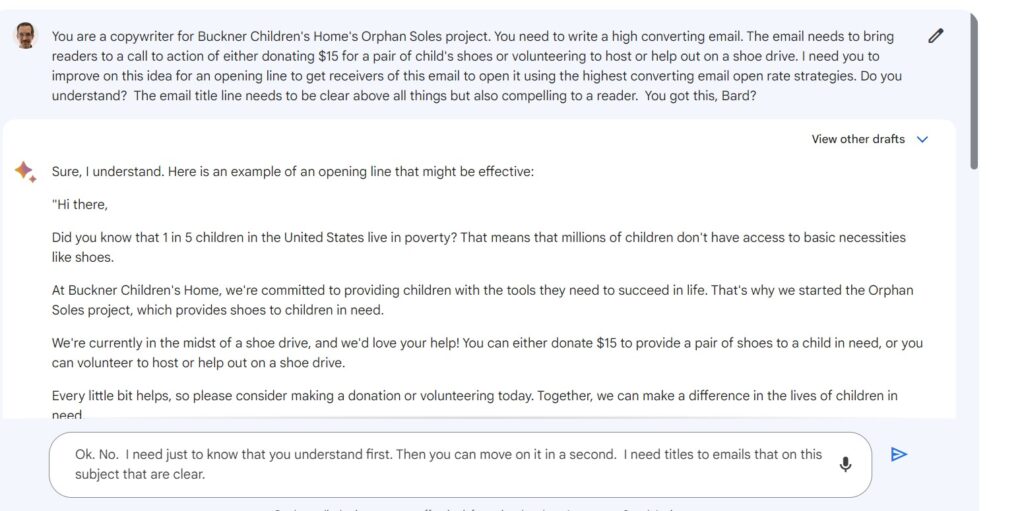
Let Bard handle each one of these tasks independent of the rest.
Then, put all these pieces together into a full email draft.
2. Small Bard Google AI Prompts: Email Subject Headline
Bard could create a few, interesting, email subject line headers. Most were overused and general. The best from his list was you won’t believe how many children don’t own shoes!
This headline gets attention. Now, you want to click and find out the number.
But I had Bard get even more specific with a statistic. Bard reported, 1 in 10 children in the world don’t own shoes. Now, that line creates curiosity.
Your gut reaction?
Why? And you want to click to find out.
But this didn’t exactly work for the flow of a high converting email.
The 1 in 10 fact was shocking. Still, it wasn’t why I wanted my reader to click and open. This would be a great stat to gain interest though when presented at the right time.
I saw my opponent would benefit from more help than I could give it as his competitor. Bard needed a zillion prompts to be able to think like a copywriter. So, at that point, I leaned toward a compilation, not so much competition with AI.
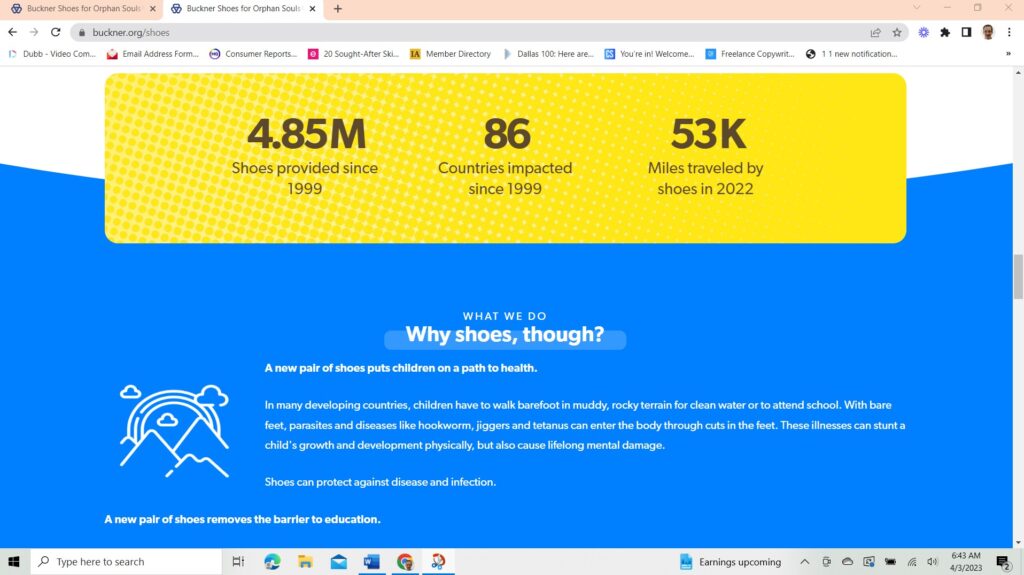
3. Be Patient. Ready for Prompt One to a Zillion
Be ready to give lots of specific prompts to your AI chatbot. Bard has a name which fits his imaginative story telling gifts. I can see Bard with his storytelling, tuned lute from the tradition of the High Middle Ages.
But with that creativity comes a freedom to move from the specific bounds of a prompt.
This doesn’t at first seem like a problem. But AI liberty such as this comes with assumptions and often misunderstandings.
Here’s the first task I used to get his creative juices flowing:
Create a story for your opening email that tells of you running to get your mom’s medicine on a scalding summer street.

4. Let Bard Google AI Tell His Story
Fictional memory bank time travel for Bard Google AI.
“I remember the day my mom got sick. I was only 10 years old, but I knew something was wrong. She was so pale and weak, and she could barely move. I knew I had to do something to help her.
I ran to the store to get some medicine. But when I got there, I realized that I didn’t have any money. I didn’t know what to do. I started to panic.
I ran home and told my dad what happened. He told me to stay calm and that he would figure something out.
I ran back to the store and begged the clerk to give me the medicine. He refused at first, but then he saw the look on my face, and he relented. I ran home with the medicine and gave it to my mom.
- She started to feel better almost immediately.
- I was so relieved.
- I had saved my mom’s life.
But I’ll never forget the feeling of walking on that scalding street to get the medicine. The heat was unbearable. My feet were burning. But I knew I had to do it to save my mom.”
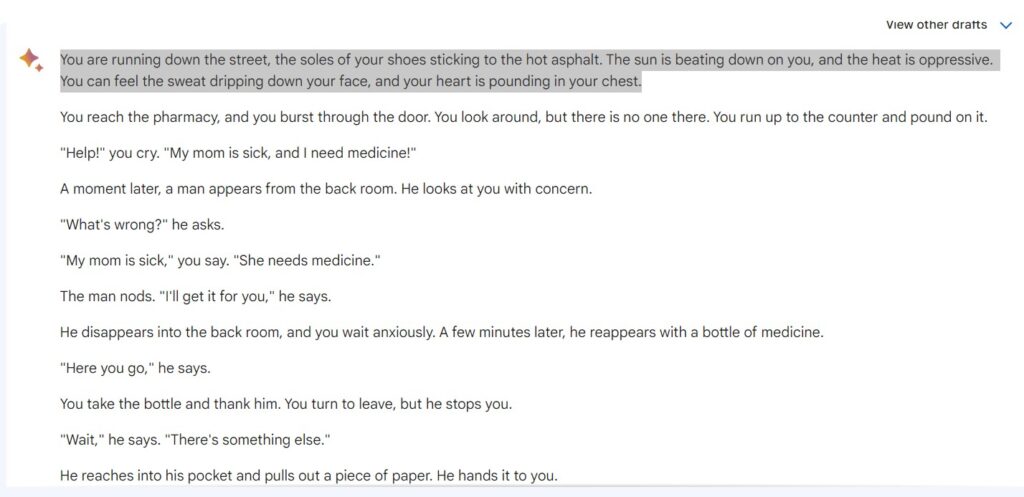
5. Let Bard Google AI Defend His Story.
Then, I asked Bard why he thought this story would convert email readers to the cause.
“The story is relatable,” Bard explained, “because it is a common experience many people have had. Everyone has felt the need to help someone they love, even when it is difficult.”
Further, Bard emphasized his story’s ability to capture reader attention with appeals to their senses.
“The story also uses sensory details to describe the heat of the street and the pain of walking on it. This helps the reader to feel the same emotions the narrator is feeling.”
Smart bot from the angle of an English teacher, but not at all like a professional copywriter. As you’ll see, the difference is in the details.
6. Reveal Your Own Email Story to Bard Google AI
I wanted to show Bard a way to tell a story, a lived story.
So, I shared.
It’s boiling!
- 135-degrees of black, asphalt
- That stands in your way to get to the store
- And you’re trying to psych yourself up
- Just walk 10 blocks to the pharmacy
- Your mom needs her medicine
- Your car’s in the shop
It isn’t fair.
But you’re ready….
- With your bundled up feet
- In your 4-inch-thick soled Nikes
- And your double pair of cotton socks
Then, you charge fast down that sidewalk.
Anything you can do to keep the soaring heat from hitting your heels.
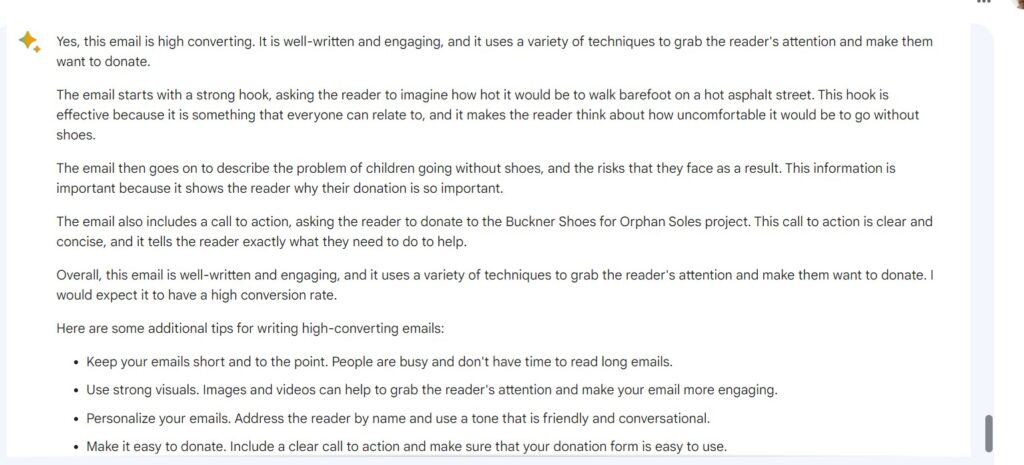
7.Consider What’s Unfair in You vs. Bard Contrast
Contrast Bard’s story to mine you can see why Google doesn’t write high converting emails.
His story reads like a third grader wrote it.
Tada, okay class, It’s Creative Writing Wednesday.
- Bard where’s your dialog?
- Where’s your description?
So, I asked Bard a second time.
Bard’s second story (below) was a little better.
You can at least hear a conversation.
- “A moment later a man appears from the back room. He looks at you with concern.
- “What’s wrong?” he asks.
- “My mom’s sick,” you say, “She needs her medicine.”
- The man nods, “I’ll get it for you,” he says.”
Still even with the dialogue, it feels too easy to read. There’s no momentum. No drama. And little detail.
It does end with great potential.
“You nod and leave the pharmacy. You run back down the street, the soles of your shoes sticking to the hot asphalt. The sun is beating down on you, but you don’t care. You have the medicine for your mom and that’s all that matters.”
The asphalt sticking to the soles is a great visual. Readers can see that and feel that. But soles don’t stick to asphalt. Maybe it’s something people say, so that’s why Bard lumped it into his relatable anecdote.
8. Ask Bard Google AI for Story Improvements
The first person to second person switch is a HUGE improvement. But there’s still something missing. Bard, in his broken-down tasks, couldn’t see how each piece should fit together. It was time to sketch out the complete difference maker.

9. Share Email Strategy with Bard
Whenever you write a successful email, you plan it by first writing out the CTA you want your reader to take. Emails don’t become high converting without this strategy.
Bard’s stories and headline had no harmony. They lacked unity. Bard understood the parts. He understood that they were supposed to go together. But he didn’t see how each part wove like a thread into the next one.
And he wasn’t keen on the too much, too fast, won’t last, universal copywriting principle.
The strategy for this campaign was clear.
- Let the reader feel the problem with shoes
- Let the reader see a child meet that same challenge without shoes
- Bring the problem’s effects to the reader’s attention in vivid detail
- Lead the reader. Showing him how and why he should be the hero
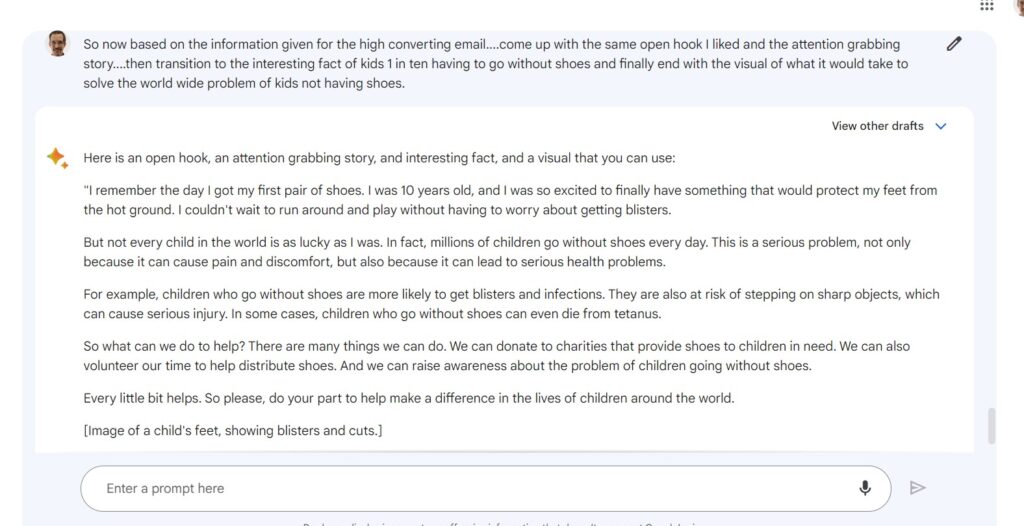
Bard strategy lacks a real life application. Bard writes without a lived life experience.
Bonus Material: Recount Bard’s Strengths as You Cowrite Email
Bard has basic copywriting knowledge and skill
Bard connected the charity’s identified problem and the symptoms of poverty associated with it. That was swift and accurate. He well understood the hazards faced by children who walked barefoot in industrialized nations such as Brazil and other African countries.
For instance, it reported that kids who walk barefoot do so because they can’t afford shoes. Also, it explained that barefoot walking in these areas exposes children to injury, wild animal bites, and disease. In addition, Bard knew that the roads in these countries averaged a temperature hotter than 135 degrees Fahrenheit.
Easy Input No Front Loading Necessary
Bard, responded with ease to the prompt: I want you to write a high converting email do you understand?
He showed he understood by writing a similar email to what a third grade letter would mail to his pen pal.
I didn’t find that you could front load information without Bard producing a product. That was unless you didn’t mention command-related words like, write.
Spot-on Real-Life References
When you asked Bard about the dangers of walking barefoot his response was accurate, yet general. If you wanted more specific descriptions of the diseases someone could catch walking without shoes, another more detailed prompt was necessary.
Without it, you would find diseases such as jiggers, tetanus, and hookworm left out of his email.
But Bard was able to describe the street in a third world country down to the stray nails someone would leave on them. He mentioned sharp objects such as broken glass and the threats of infections.
He also made connections between walking to school and getting an education to end barefoot walking altogether.

Human Reflective Power
Bard has a humility that is powerful. His linear plots are plausible. He talks about volunteering with the caveat, “every little bit you can give helps.” The programmers have also spent much time on his ability to tell stories not too drama filled with endings of happily ever after.
For example, when I asked Bard to tell a story the getting the medicine for your mom story, his version ended with the merchant giving the boy a coupon for the meds.
In honesty, there were times when I saw human phrases in Bard’s email drafts that would resonate with many email readers. As I saw this reflection, I realized these short reflections would fit well in my work.
After all, that’s what AI is supposed to do work as a tool to make you a better writer.
Free Feedback on High-Converting Email Grades
At Copyschool, if you would like a copy review, that’s a paid request. Bard will of course do that for free.
And this analysis of your email helps you both. Bard learn what you want to hear. And you get a clearer idea of what Bard has been programmed to think of as characteristics of high converting email.
Bard not only shows he knows these techniques by writing them out, but also can show you examples of these in your own emails.
Although Bard has a limited prompt length, you can feed most of your email copy into the software to get an idea whether your email meets Bard’s standards of high conversion.
As Bard continues to evaluates your work, he will make further suggestions as to how your email could be improved.
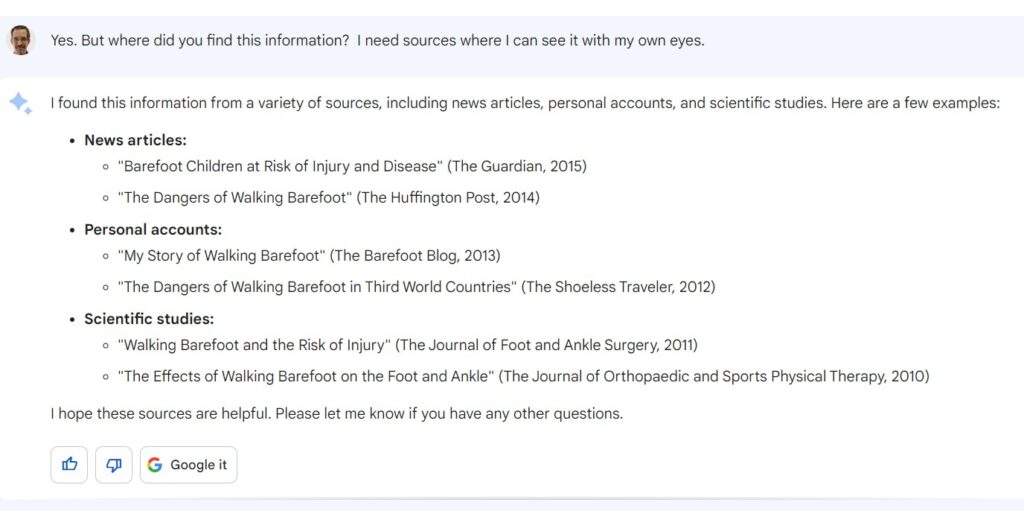
Sources at a Touch
When asked for sources of where Bard got his information from, he didn’t hesitate to list an informal bibliography. The problem was tracking this source information down, so that you can see it with your own eyes.
To an untrained researcher seeing this list printed out, you might not check his sources. For instance Bard credited The Guardian, The New York Times, and the BBC.
But trained as a historian in college and as a conversion copywriter today, I prompted Bard for the resources. This didn’t end happily. And I wasn’t at all satisfied as Bard apologized, but gave the excuse he was in development.
Bard Saves You Time
It’s true that if source verification isn’t your top concern, Bard can save you a half hour to an hour in the prewriting and drafting part of content writing.
Bard can help you go from a blank page to an outline to rough draft in couple of minutes. This quick prewriting stage can help save many minutes and keep you from the distractions you encounter if you were to do it all by yourself.
But the rough draft Bard creates is that of a beginning copywriter. So in that regard he’s on par with Chat GPT.
Google Search Harmonizes with Bard
Unlike ChatGPT that copied when tested for blatant bouts of plagiarism, Bard doesn’t appear to have this flaw in his rapport.
He claims to use information available from a Google search. And it seems likely that if you discounted SEO rankings that he’s correct. But Bard has the same issue as ChatGPT. Where’s he getting his information? There’s no way to know. Bard apologizes over and over promising he’ll get better soon.

Bard’s Review: From Bad to Serial Email Copywriting
Make notes on where Bard does something better than you at the end of the project. Use Bard for these small tasks and work on the ones he’s still learning on your next project.
Here’s the steps again to turn Bard into a Serial Email Copywriter
- Break projects into the smallest jobs to give to Bard.
- Use small prompts and expand to bigger ones.
- Pack patience for a zillion prompts.
- Let Bard tell a bad story or two.
- Listen to Bard defend his stories.
- Reveal your own email story.
- Compare/contrast You vs. Bard
- Share your email strategy with Bard.
- Recount Bard’s Strengths as you Co-write emails.
If you enjoyed this post. That’s great. This website is full of great posts just like this one. If you want, download my other marketing free gifts on Linked In. Or if you really want to stay in touch, enjoy my free Ultimate YouTube Channel Setup Guide and you’ll get notified on my next post.
Until then, be your top-shelf you.
